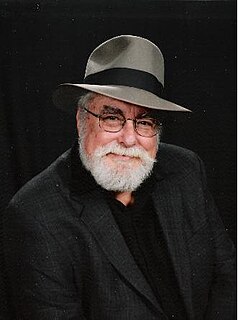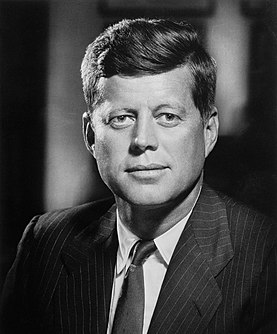
Lee Harvey Oswald was a U.S. Marine veteran who assassinated John F. Kennedy, then president of the United States, on November 22, 1963.

Walter Leland Cronkite Jr. was an American broadcast journalist who served as anchorman for the CBS Evening News for 19 years (1962–1981). During the 1960s and 1970s, he was often cited as "the most trusted man in America" after being so named in an opinion poll. Cronkite reported many events from 1937 to 1981, including bombings in World War II; the Nuremberg trials; combat in the Vietnam War; the Dawson's Field hijackings; Watergate; the Iran Hostage Crisis; and the assassinations of President John F. Kennedy, civil rights pioneer Martin Luther King Jr., and Beatles musician John Lennon. He was also known for his extensive coverage of the U.S. space program, from Project Mercury to the Moon landings to the Space Shuttle. He was the only non-NASA recipient of an Ambassador of Exploration award. Cronkite is known for his departing catchphrase, "And that's the way it is", followed by the date of the broadcast.

Operation Northwoods was a false flag operation against American citizens that originated within the US Department of Defense of the United States government in 1962. The proposals called for CIA operatives to both stage and actually commit acts of violent terrorism against American military and civilian targets, blaming them on the Cuban government, and using it to justify a war against Cuba. The possibilities detailed in the document included the remote control of civilian aircraft which would be secretly a repainted US Air Force plane, the possible assassination of Cuban immigrants, sinking boats of Cuban refugees on the high seas, blowing up a U.S. ship, and orchestrating terrorism in U.S. cities. The attacks on Americans were not supposed to be violent, while the attacks on Cuban refugee boats were supposed to be "real or simulated", with the maximum extent of wounding them for media publicity. The proposals were rejected by President John F. Kennedy.

James Farrell Marrs Jr. was an American newspaper journalist and New York Times best-selling author of books and articles on a wide range of alleged cover-ups and conspiracies. Marrs was a prominent figure in the JFK assassination conspiracy theories community and his 1989 book Crossfire was a source for Oliver Stone's 1991 film JFK. He wrote books asserting the existence of government conspiracies regarding aliens, 9/11, telepathy, and secret societies. He began his career as a news reporter in the Dallas–Fort Worth–Arlington metroplex and taught a class on the assassination of John F. Kennedy at University of Texas at Arlington for 30 years. Marrs was a member of the Scholars for 9/11 Truth.

James Carothers Garrison was the District Attorney of Orleans Parish, Louisiana, from 1962 to 1973. A member of the Democratic Party, he is best known for his investigations into the assassination of President John F. Kennedy and prosecution of New Orleans businessman Clay Shaw to that effect in 1969, which ended in Shaw's acquittal. The author of three books, one became a prime source for Oliver Stone's film JFK in 1991, in which Garrison was portrayed by actor Kevin Costner, while Garrison himself also made a cameo as Earl Warren.
Abraham Zapruder was a Ukrainian-born American clothing manufacturer who witnessed the assassination of United States President John F. Kennedy in Dallas, Texas, on November 22, 1963. He unexpectedly captured the shooting in a home movie while filming the presidential limousine and motorcade as it traveled through Dealey Plaza. The Zapruder film is regarded as the most complete footage of the assassination.

Dorothy Mae Kilgallen was an American columnist, journalist, and television game show panelist. After spending two semesters at the College of New Rochelle, she started her career shortly before her 18th birthday as a reporter for the Hearst Corporation's New York Evening Journal. In 1938, she began her newspaper column "The Voice of Broadway", which was eventually syndicated to more than 140 papers. In 1950, she became a regular panelist on the television game show What's My Line?, continuing in the role until her death.

Bill Kurtis, known professionally as Bill Kurtis, is an American television journalist, television producer, narrator, and news anchor.

This article considers the detailed timeline of events before, during, and after the assassination of John F. Kennedy, the 35th president of the United States.

Around the world, there were shocked reactions to the assassination of John F. Kennedy, the President of the United States, on Friday, November 22, 1963 in Dallas, Texas.

John Fitzgerald Kennedy, often referred to by his initials JFK and also known as Jack Kennedy, was an American politician who served as the 35th president of the United States from 1961 until his assassination near the end of his third year in office. Kennedy was the youngest person to assume the presidency by election. He was also the youngest president at the end of his tenure. Kennedy served at the height of the Cold War, and the majority of his work as president concerned relations with the Soviet Union and Cuba. A Democrat, he represented Massachusetts in both houses of the U.S. Congress prior to his presidency.
The John F. Kennedy assassination and the subsequent conspiracy theories surrounding it have been discussed, referenced, or recreated in popular culture numerous times.

On April 4, 1968, United States Senator Robert F. Kennedy of New York delivered an improvised speech several hours after the assassination of Martin Luther King Jr. Kennedy, who was campaigning to earn the Democratic Party's presidential nomination, made his remarks while in Indianapolis, Indiana, after speaking at two Indiana universities earlier in the day. Before boarding a plane to attend campaign rallies in Indianapolis, he learned that King had been shot in Memphis, Tennessee. Upon arrival, Kennedy was informed that King had died. His own brother, John Fitzgerald Kennedy had been assassinated on November 22, 1963. Robert F. Kennedy would be also assassinated two months after this speech, while campaigning for presidential nomination at the Ambassador Hotel in Los Angeles, California.

The Zapruder film is a silent 8mm color motion picture sequence shot by Abraham Zapruder with a Bell & Howell home-movie camera, as United States President John F. Kennedy's motorcade passed through Dealey Plaza in Dallas, Texas, on November 22, 1963. The film captures the moment of the President's assassination.

On June 5, 1968, Robert F. Kennedy was shot by Sirhan Sirhan shortly after midnight at the Ambassador Hotel, Los Angeles. He was pronounced dead at 1:44 a.m. PDT the following day.

Martin Luther King Jr., an African-American clergyman and civil rights leader, was fatally shot at the Lorraine Motel in Memphis, Tennessee, on April 4, 1968, at 6:01 p.m. CST. He was rushed to St. Joseph's Hospital, where he died at 7:05 p.m. He was a prominent leader of the civil rights movement and a Nobel Peace Prize laureate who was known for his use of nonviolence and civil disobedience.
Joe Garner is a former radio executive, American author, and keynote speaker who resides in Los Angeles.
This is a list of British television related events from 1963.
The conspiracy theories relating to the assassination of Robert F. Kennedy, a United States senator from New York, relate to non-standard accounts of the assassination that took place shortly after midnight on June 5, 1968, in Los Angeles, California. Robert F. Kennedy was assassinated at the Ambassador Hotel, during celebrations following his successful campaign in the Californian primary elections while seeking the Democratic nomination for U.S. President; Kennedy died the following day at Good Samaritan Hospital.

The United States' Central Intelligence Agency made numerous unsuccessful attempts to assassinate Fidel Castro during his time as the president of Cuba.















